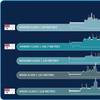APM Terminals Intros Monitoring System
APM Terminals, an international container terminal operating company headquartered in The Hague, has commenced the global rollout of an advanced application monitoring solution, capable of spotting issues with performance before they start to negatively impact operations.
The new solution, which has already been rolled out to 11 terminals, will ensure business continuity, improve terminal efficiency, and safeguard consistency (peak moves per hour) by ensuring that applications consistently operate at the speed they’re supposed to. It will also prevent minor problems from combining to cause a major outage.
According to APM Terminals Global Capability Manager, David Pickup, “This industry first provides the same level of service normally only provided by advanced IT companies to their customers.”
Traditionally the company relied on the basic monitoring offered by the suppliers of the company’s global standard terminal operating system (TOS) Navis. This year, the company’s TOS Support teams and Global Core Capability Centre (GC3) have established a new application monitoring capability that combines Riverbed and Elastic technologies. GC3 was established in 2018 to provide unrivaled internal technical capability around TOS.
Instead of simply monitoring isolated points, the solution monitors end-to-end performance – including code, application architecture, servers, disk space, databases, user endpoints and more. The data is fed into one central dashboard, which is monitored 24/7 by the Maersk global Command & Control Center in the UK and the GC3 support team.
“The dashboard operates using a simple traffic light system,” says David Pickup. “Green means that no issues are detected. Amber flags have the potential to impact the business. Our goal is to fix these before they turn to red flags. Red flags indicate that the issue is probably already impacting our operations. This new solution enables us to identify any issues before the end user even notices that something isn’t working as it should.”
Asked about real-life examples, Mr Pickup explains that the company’s databases should automatically purge themselves of old data, to ensure that they don’t run out of disk space. “There are a number of reasons why this could go wrong,” he says. “For example, a user running a query that blocks the database. At a specific threshold, we’d already want to be flagging this and investigating the reason before it impacts system performance.”











